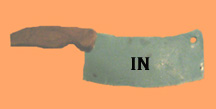Home | About | In | Out | Us | Them | Table of Contents
After seeing an Asian woman collecting ginkgo fruit in the neighborhood, I got curious about what exactly people did with it. I went back inside to Google "ginkgo fruit," then "ginkgo nut," then finally "ginkgo nut recipe." Within 15 minutes I was back outside with a plastic bag to collect some.
The female Ginkgo trees that drop fruit on the ground look like this:

And this is what the sidewalk under that tree looked like:

I moved carefully around the base of the tree so as not to get too much of the smashed rotting pulp on my shoes and fairly quickly collected a couple dozen of the unbruised, intact fruit.
Some people online suggest wearing latex gloves when working with ginkgo fruit, but after opening my bag spreading some of the intact fruit on the counter, I decided it probably wasn't necessary -- it seems that the intact fruit does not actually smell all that bad. After taking the ginkgo inside, I wonder whether the notorious ginkgo smell comes from rotting fruit and not fresh fruit.


The first thing I did was rinse the fruit with one of those vegetable washing soaps -- I collected these from the sidewalk, after all. After rinsing the fruit, I separated the fruit flesh from the nut within. I started out cutting the fruit away with a knife, but the knife is unnecessary -- the fruit is easily removed from the nut. The result looked like this:

I then rinsed the nuts. Here is what the ginkgo nuts look like clean with all the fruit removed:

I scrubbed my hands and returned to the computer to consult some recipes, eventually coming up with two plans: 1) simple toasting and 2) boiling the nuts and sauteeing them with beef stock-style liquid and a lot of salt.
First, toasting. I toasted the nuts in their shells in the oven. After a few minutes, I tried one:

The taste was pretty good actually -- a lot like a chestnut (and a lot easier to prepare than a chestnut). You'll see that some quick toasting gives the fruit a brownish color:

Next, I tried boiling the nuts. Boiling them for a few minutes gives you a nut that looks like this:

The boiled nuts are only OK -- gummy and fairly bland -- but a Times article about ginkgo nuts features a chef cooking them in a little water, just enough to partially immerse the nuts, with some salt. His recipe involves cooking the beans until all the water has evaporated out of the pan and the nuts are dry.
I went a little different direction, using half water and half liquid from an earlier beef and vegetable stir fry -- along with a lot of salt. I boiled out all the water the same way and tried a nut -- the gumminess from before had disappeared and the salty beefiness gave the nut some slight but not too overwhelming flavor.
I don't think it matters exactly what liquid you use -- probably any generously salted gelatinous stock would work fine, i.e., something with flavor and at least a little fat. All I used was old stir fry juice, and it tasted good. The toasted version is on the left and the recipe from the Times is on the right. We drank beer with these:

You'll notice the toasted nuts in the above picture are much darker than the first toasted trial -- these were crunchy and less chestnut-like. I preferred the less toasted version, and if I were to do this again, I'd make sure the nuts retained their softness and would pull them out of the oven sooner.
--Scott

Links
"Gathering Ginkgo Nuts in New York," Gourmet Magazine, November 3, 2008
"What's That Smell in the Park? It's Dinner," New York Times, November 17, 2004
"Smells Like Hell, Tastes Like . . . Chestnuts Sort Of" Slightest Entry, November 9, 2010

Back to Bridge and Tunnel Club Home
Contact the Cleaver:
info -at- bridgeandtunnelclub.com



